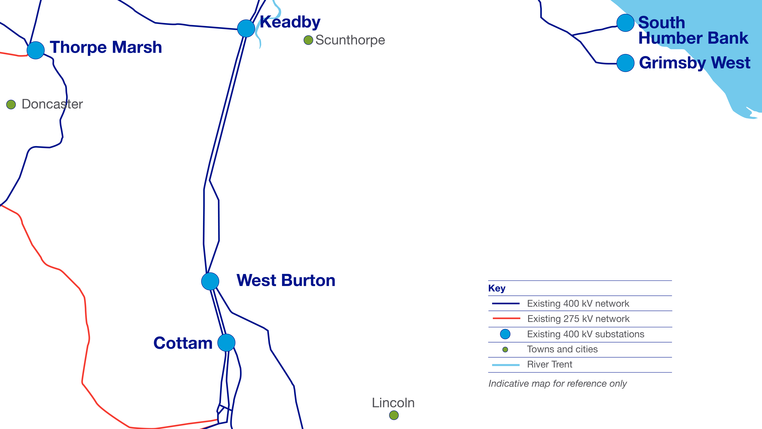Our two overhead lines running between Keadby and Cottam, and Keadby and West Burton in the Trent Valley have been in service since the mid-1960’s and 1970s respectively.
Essential refurbishment and upgrade work was needed to ensure that the lines continue to provide a safe and reliable supply of electricity for years to come.
All overhead line reconductoring and tower work was successfully completed in November 2024. We would like to thank the local community for their patience and understanding as this work was carried out.
The final stage of the project will involve improving the foundations of pylons across the overhead line routes.
Improving the electricity transmission network
In the Trent Valley, the electricity transmission network was built to connect major coal fired generation at Keadby, Cottam, Staythorpe, West Burton and High Marnham. The electricity is carried on towards major population centres, flowing primarily from the North to the Midlands.
With the significant growth in offshore wind and increasing interconnection with other countries, the power carrying capability of the network needs to be increased significantly.
The refurbishment has increased the capability of the electricity transmission network in the Trent Valley region.
Because both lines run parallel for much of their route, we decided to refurbish both Keadby to Cottam and Keadby to West Burton routes at the same time. This has minimised the impact on stakeholders, landowners, and local communities.

Keadby to Cottam
The 400 kV overhead line running between Keadby in Lincolnshire and Cottam in East Yorkshire is approximately 35 km in length. We have replaced the wires that run between the pylons to deliver more power carrying capability, helping transport cleaner, greener energy from where it is generated to homes and businesses.
Keadby to West Burton
We have increased the capability of the Keadby to West Burton line in Lincolnshire, which is 28 km long. Wires on the line have been replaced due to asset health reasons. As part of our work, we replaced the existing parts, so that the line can now carry more power.
What can you expect to see?
The maintenance work started in March 2024 and all of the reconductoring work was successfully completed in November 2024.
The remaining work will involve improving the foundations of pylons along both of the routes.
The work is being carried out by Morrison Energy Services, on behalf of National Grid. This work is anticipated to take place over the next year.
Working hours will be Monday to Friday between 7am and 6pm.
The refurbishment work will have no impact on power supplies in the area.
We aim to complete the works with minimal disruption to local communities. We expect there will be very limited road closures. You may notice temporary traffic management signage for site access, for example when we install scaffolding and netting underneath the overhead line where we will carry out our work.
Most of the pylons are on farmland but where the pylons are closer to individual homes and businesses, we will notify the occupiers of those properties in advance.
Our Community Grant Programme is aimed at organisations and charities in areas where National Grid’s work impacts local people through our operations and site activities.
We provide grants for community-based initiatives run by charities and community groups that meet local community needs by providing a range of social, economic and environmental benefits. If your project meets our criteria, you can click here to find out more about how to apply here.